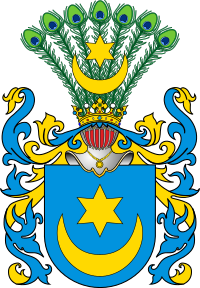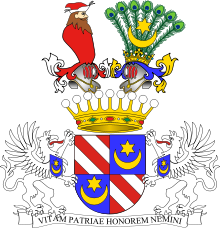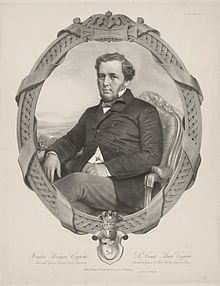Czapski (noble family)

Czapski or Hutten-Czapski is the name of an old noble family from Pomerania . Some branches were given the title of count , belonged to the Polish magnates and have continued to this day.
Origin and history
The eponymous headquarters of Czapel in the Schwetz district is associated with the family as early as 1300. Piotr de Czapelken, 1395, is tangible for the first time, the family line begins with Marcin Czapski, Herr auf Czapel 1526. In the Prussian area , the German form of the name Hutten, which is a translation of the Polish word "czapka" (cap), was also used. to "Hutten" (hat) is an interpretation of the name of origin. A connection to the Franconian noble family Hutten is a baroque legend that has long been considered refuted in research, but which persistently spread.
The rise of the family from the Panenadel to large landowners with high positions began from the home of Pomerania . In the course of time the family produced four voivodes (palatins), six castellans (Polish burgraves), two bishops and five Polish generals. Five members carried the Order of the White Eagle , the highest honor in Poland. The Hutten-Czapski enjoyed a special reputation under King Stanislaus II August Poniatowski . The family spread from Pomerania, later West Prussia , across Poland, with branches in Lithuania , Russia and Volhynia . There were marriage ties to well-known Polish families, such as B. the princes Czetwertyński and Radziwiłł , the counts Działyński , Małachowski, Mielżyński, Potocki , Raczyński , Rzewuski and Zamojski.
On March 19, 1923, a family association was founded in Poznan .
Status surveys
As early as the 18th century, the Czapski asserted their claim to the title of count without any evidence of ennoblement.
The Prussian counts came on September 27, 1804 in Potsdam to the brothers Nikolaus and Joseph von Hutten-Czapski, West Prussian vassals and royal Polish major general, as well as on November 3, 1861 in Berlin according to the law of the firstborn , linked to the Smogulec property to Count Bogdan von Hutten-Czapski .
The brothers Adam, Ignacy and Emmerich Hutten-Czapski were on 12 June 1874 in the Russian Count enstand lifted in 1900 or 1907 that was ennobling on the Russian total line extended.
Distribution and historical ownership
- in Pomerania / West Prussia: Fideikommiß Bukowitz , Schwetz district; Fideikommiss Smoguletz (approx. 3500 ha), Wongrowitz district ; Fideikommiß Sumowo, Michelau district
- in Lesser Poland : Majorate Skąpe, Przedbórz County
- in Lithuania: Lordship and town of Kedahnen (20,000 ha) near Kaunas
- in today's Belarus : rule Stankowo, Gouvernement Minsk
- in Volhynia: Miropol (Miropol'ye)
coat of arms
The main coat of arms of the Polish coat of arms community Leliwa shows in blue a golden crescent moon that is open at the top and a golden star in the opening. On the helmet with blue-gold covers, a natural peacock feather covered with the shield image.
With reference to the legendary descent from the Franconian Hutts, the Counts Hutten-Czapski carried an increased coat of arms, Russian award on June 12, 1874 for Emeryk and his brothers: square with the (varied color) shield of the Franconian Hutts and the family coat of arms Leliwa above the helmets of both families; as a shield holder, silver griffins with the Leliwa shield on the chest and the motto: "Vitam patriae, honorem nemini".
Personalities
- Sebastian Hutten-Czapski (around 1640–1699), castellan of Kulm , chamberlain of Marienburg
- Jan Chryzostom Hutten-Czapski (1656–1716), castellan of Elbing 1699, castellan of Kruszwica
- Piotr Aleksander Hutten-Czapski (around 1670–1717), voivode of Pommerellen 1716, castellan of Kulm since 1710, castellan of Kruszwica 1703, senator in the Kingdom of Poland
- Franciszek Tomasz Hutten-Czapski (d. 1733), Bishop of Kulm 1731, previously abbot of Pelplin Monastery 1702–1730
- Jan Ansgary Hutten-Czapski (around 1690–1742), Voivode von Kulm and Grand Hunter of the Polish Crown 1732, Knight of the White Eagle Order 1732
- Michał August Hutten-Czapski (1702–1797), Voivode of Marienburg, Knight of the White Eagle Order 1758
- Walenty Aleksander Hutten-Czapski (around 1710–1751), Bishop of Kujawy 1741, Bishop of Przemyśl , previously abbot of Pelplin Monastery in 1734, Knight of the White Eagle Order in 1740
- Franciszek Hutten-Czapski (around 1700–1736), castellan of Danzig 1725, senator in the Kingdom of Poland
- Ignacy Hutten-Czapski (around 1700–1746), castellan of Danzig 1737, senator in the Kingdom of Poland
- Józef Hutten-Czapski (1722–1765), Polish Major General, Castellan of Elbing, Senator in the Kingdom of Poland, Knight of the Order of the White Eagle 1760
- Franciszek Stanisław Kostka Hutten-Czapski (1725–1802), Voivode von Kulm, Castellan of Danzig, Senator in the Kingdom of Poland, member of the four-year-old Sejm , Knight of the Order of the White Eagle in 1762
- Antoni Hutten-Czapski (1725–1792), Polish Lieutenant General 1784, Adjudant General of King Stanislaus II August, holder of the Order of St. Stanislaus 1766
- Mikołaj Hutten-Czapski (1753–1833), Polish major general, chief of the Polish cavalry, holder of the Order of St. Stanislaus, lord of Bukowiec
- Urszula Hutten-Czapska (around 1730–1782), married in 1773 to Count Stanisław Małachowski , Polish statesman, author of the constitution of 1791 and initiator of the four-year Sejm; he married her younger sister Konstancja Hutten-Czapska (around 1740–1782), widowed Princess Radziwiłł
- Marian Hutten-Czapski (1816–1875), natural scientist and biologist, Imperial Russian Chamberlain, Herr auf Kedahnen, author of the history of the horse , 3 vols., Poznań, 1874 (German edition: Berlin, 1876)
- Emmerich Hutten-Czapski (1828–1896), Vice-Governor of St. Petersburg , Governor of Novgorod , General Director of the Russian Forest Administration, Chamberlain of the Tsar, member of the Russian Geographic Society. He was a well-known numismatist , book and art collector, whose collections were donated to the city of Krakow in a specially built palace in 1903 as the Emmerich Hutten Czapski Museum and part of the National Museum
- Bogdan von Hutten-Czapski (1851–1937), Prussian-Polish politician, author of political books, hereditary member of the Prussian mansion , entrant on Smogulec. Throughout his life he endeavored to achieve a German-Polish balance
- Alexandrine von Hutten-Czapska (1854–1941), married in 1885 in a second ( morganatic ) marriage to Grand Duke Ludwig IV of Hesse-Darmstadt . The marriage was annulled for dynastic reasons, which caused a scandal.
- Józef Czapski (1896–1993), Polish author and painter who succeeded Fauvism and Paul Cézanne
literature
- Max Bär : The nobility and aristocratic property in Polish Prussia at the time of the Prussian occupation. Based on extracts from the vassal lists and land registers. Leipzig 1911
- Adam Boniecki (and Artur Reiski): Herbarz Polski. Warszawa, 1899-1913, Vol. 3, pp. 176-282
- Jerzy Dunin-Borkowski: Genealogy żyjących utytułowanych rodów polskich. Lwów, 1895, pp. 186–195
- Jerzy Dunin-Borkowski: Almanach błękitny, genealogia żyjących rodów polskich. Lwów-Warszawa, 1908, pp. 184-298
- Genealogisches Handbuch des Adels , Adelslexikon Volume II, Volume 58 of the complete series, p. 385, CA Starke Verlag , Limburg (Lahn) 1974, ISSN 0435-2408
- Gothaisches Genealogisches Taschenbuch der Graefliche Häuser B, Görlitz, 1939
- Ernst Heinrich Kneschke : German count houses of the present: In heraldic, historical and genealogical relation. Volume 3, Leipzig 1854, pp. 72–74 (digitized version)
- Leopold von Ledebur : Nobility Lexicon of the Prussian Monarchy . Volume 1, Berlin 1855, p. 153 (digitized version)
- Marek Jerzy Minakowski: Wielka Genealogia Minakowskiego. Kraków, 2009 pp. (CD-ROM)
- Polish Biographical Lexicon , Warszawa, Volume IV, 1938, pp. 177-196
- Teodor Żychliński : Złota księga szlachty polskiej. Poznań, 1879-1908, Vol. 9, pp. 49-87
Web links
- Marek Jerzy Minakowski: Genealogia Potomków Sejmu Wielkiego. (Descendants of the members of the four-year-old Sejm), online project (Polish)
- Emeryk Hutten-Czapski Muzeum, Kraków Museum website (English)
- historical-genealogical outline of the Hutten-Czapski (Russian)
Individual evidence
- ↑ in detail in Zychliński, Vol. 11, p. 49; also with Simon Konarski: Armorial de la noblesse polonaise titrée. Paris, 1957
- ^ Kneschke , Deutsche Grafenhäuser , 1854, p. 72f .; Goth. Geneal. Taschenbuch , Graefliche Häuser B, 1939, p. 106; also with Georg-Wilhelm Hanna : ministeriality, power and mediatization. The knight nobles von Hutten, their social position in church and state until the end of the Old Kingdom Dissertation on the OPUS server (PDF 7,024 kB) , Bamberg 2006, p. 123, FN 836. Bogdan Graf von Hutten-Czapski even acquired the in 1904 old Huttengrund in the Hessian Romsthal near Bad Soden-Salmünster, but withdrew to Poland in 1919.
- ↑ Zychliński, Vol. 11, p. 62
- ↑ Juliusz Ostrowski: Księga Herbowa rodów polskich. Warszawa 1897-1906, Vol. 1, p. 192; Vol. 2, p. 112





